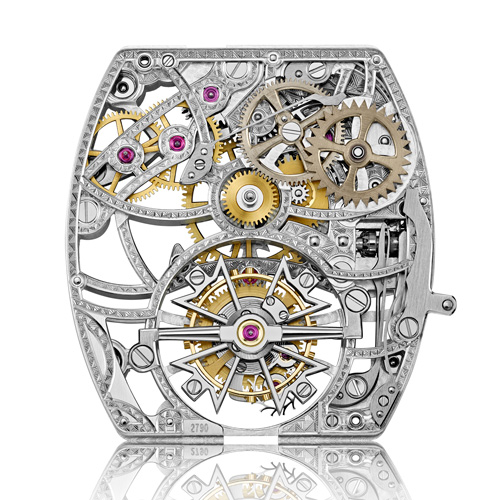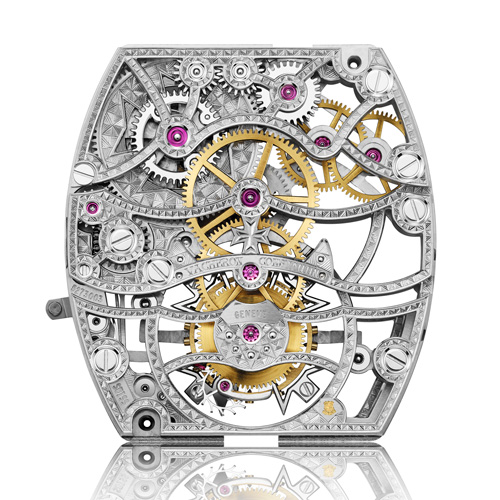
Light and shadow effects
Vacheron Constantin introduces its very own solution to the complex equation with its Malte tourbillon openworked model, since this creation sets the stage for such a demanding complication as the tourbillon within an entirely openworked shaped calibre – all entirely developed and crafted within the Manufacture, and also bearing the prestigious Hallmark of Geneva. A genuine rarity in the realm of Fine Watchmaking.
At Vacheron Constantin, technical excellence has always gone hand in hand with stylistic research. The first watch created by Jean-Marc Vacheron in 1755 indeed already featured an openworked and engraved balance-cock, laying the foundations for the quest for transparency and airy lightness that would continue through the years and reach a peak between 1920 and 1990. This period witnessed an abundance of openworked calibres for pocket-watches and wristwatches, ranging from the simplest to the most complicated; and it is precisely one of the major horological complications – the tourbillon – that Vacheron Constantin has chosen this year for exploring new horizons in the demanding art of openworking.
A horological high-wire act
Developing and crafting a tonneau-shaped calibre entirely in-house calls for exceptional mastery of mechanical horology. Openworking it and staging it within an ethereally light architecture while infusing it with a sense of volume and creating striking light and shadow effects represents the ultimate challenge. Such is precisely the tour de force Vacheron Constantin has accomplished with its new Calibre 2790 SQ beating at the heart of the Malte tourbillon openworked model.
This movement has drawn upon the combined experience of the finest watchmakers and artisans of the Manufacture. The conception, modelisation and design of this calibre took these masters of their craft over 500 hours of striving to achieve the perfect balance between a fully functional tourbillon mechanism and the transparent openworked aesthetic. Depending on the angle from which the watch is viewed, a subtle interplay of light and shadow is created within the depths of the calibre, accentuated by the three-dimensional effect of the architectural motif stemming from a new approach to hand engraving.
Stylistic research around a geometrical structure
Geometrical shapes have always inspired the greatest builders, architects and artists, playing with light according to the position of the sun or forming a pyramid of chiaroscuro contrasts based on basic geometrical elements arranged in layers. Inspired by these works, Vacheron Constantin has devised an original architectural motif based on the shape of a triangle to provide a unique interpretation of hand engraving. Once again demonstrating the impressive range of their art, the artisans of the Manufacture performed truly stunning work on the surface of the parts composing Calibre 2790 SQ. In a succession of meticulous strokes of the burin that sometimes involves working to the nearest tenth of a millimetre, they have created tiny triangles composed of recurrent straight lines creating a three-dimensional effects, before hand-drawing and chamfering the 246 parts of the calibre. This geometrical mosaic forms an architecture generating an astonishing volume effect through light and shadow effects further enhanced by the airy structure of the imposing tourbillon carriage.
The Hallmark of Geneva certifies the excellence of the watch
The fascinating construction of Calibre 2790 SQ is framed by a tonneau-shaped platinum case closely following the lines of this exceptional mechanism that also powers a date display and a power-reserve indication. Made in sapphire like the case-back, the dial is rimmed by a slate- grey ring featuring elegant metallic hour-markers, while the minute circle is painted and the date, power-reserve and seconds indicators are engraved and inked. The tourbillon carriage at 6 o’clock spins over a Maltese Cross, sweeping the small seconds hand along with it. The Malte tourbillon openworked model bears the prestigious Hallmark of Geneva, the highest benchmark in Fine Watchmaking testifying to the quality, craftsmanship and reliability of an exceptional timepiece crafted within the confines of Canton Geneva.
The art and technique of openworking
Far more than a mere object of mechanical excellence indicating the time, a timepiece by Vacheron Constantin is by essence destined to be a full-fledged work of art capable of revealing all the beauty of unique expertise enriched by over 260 years of history. Ever since its founding in 1755, the Manufacture has consistently enhanced the beauty of its creations through artistic crafts exercised by skilled artisans. Hand engraving is one such technique. A demanding art calling for exceptional patience and dexterity, it was used right from the start as a means of achieving ethereal lightness. The first watch created by Jean-Marc Vacheron in 1755 already featured an openworked and engraved balance-cock. The quest for transparency then continued, with increasingly finely fashioned mechanical parts, leading to the creation in 1924 of the first entirely openworked calibre beating at the heart of a pocket watch. A past master in the practice of this extremely intricate discipline, Vacheron Constantin has given free rein to its creativity, progressively openworking both simple and complicated calibres, associating them according to its inspiration with other artistic crafts, and interpreting these miniature marvels both on pocket-watches and wristwatches from the 1960s onwards.
Not content with being one of the rare manufacturers capable of openworking such complex calibres as minute repeaters, perpetual calendars and tourbillons, Vacheron Constantin once again pushes the boundaries of its art by reinventing both the technique itself and the aesthetic codes governing it. The engraving thus becomes a sculpture, as the straight lines morph into interlacing curves, while the watch parts become architectural works creating mesmerising light effects.
Openworking, or the art of
transparent and ethereal mechanical magic
The all-important initial touch of the watchmaker
While openworking is a purely aesthetic approach in itself, it nonetheless induces additional complexity at each stage compared with a solid calibre. Everything begins with a lengthy consideration of the movement that is to be openworked as much as possible so as to reveal its inner beauty. This calls upon the full wealth of experience of the finest master-watchmakers, since it involves achieving a subtle balance between hollowing out as much of the material as possible, while ensuring that the calibre remains perfectly functional. The conceptualisation, design and modelisation phases take several hundred hours, a figure that increases in step with the level of sophistication of the calibre, particularly in terms of complications.
Enter the artisans
Once this subtle balance has been found, the artisans take over, marking the start of a long period of patient, accurate and rigorously disciplined endeavours. The mainplate, bridges, barrel and other mechanical parts that have been previously drilled and cut out occupy their nimble fingers for dozens of hours until they are ready to reveal their appealing new face. Working by hand with each component in turn, the artisans create subtle contrasts between the finished polish of the chamfering that will catch the light, and the matt effect of the hand- drawing that will accentuate the radiance. While this is in itself a demanding task, it is rendered even more complex by the curved openings and interior angles – some narrower than 45° – favoured by Vacheron Constantin in its openworked creations, and which no machine could possible reproduce.
The chamfering and hand-drawing are followed by the engraving itself. For around one full week for each calibre, the engraver incises and sculpts the material with meticulous strokes of the burin in order to create the original motifs imagined by Vacheron Constantin, giving them their delightfully rounded relief. Each gesture is highly accurate – in some cases to the nearest tenth of a millimetre – and the aesthetic sensitivity of the artist-artisan is finely attuned to instilling each component with unique character.
Back to the workbench
Assembling and adjusting an openworked calibre is a particularly complex task, since the loss of material resulting from the openworking inevitably leads to certain distortions of the parts. For the watchmaker, this means retouching them again and again until their impeccable interaction is guaranteed. Throughout this lengthy process, he makes sure that no dust settles in the hollowed-out surfaces, and also carefully complies with the extremely stringent standards imposed by the Hallmark of Geneva. He devotes special attention to each part, notably the chamfered parts, so as to ensure their perfect aesthetic and functional execution. This perfection is once again severely tested when casing up the movement, since the transparency stemming from the openworking highlights every single perfection, however tiny. Well before the start of the long sequence of water-resistance, reliability and precision testing begins, the calibre returns several times to the workbench until the full magic of a masterfully executed openworked movement begins to weave its spell. Just as as in other fields, the exceptional in terms of horology stems from an ideal blend of excellence and patience.










